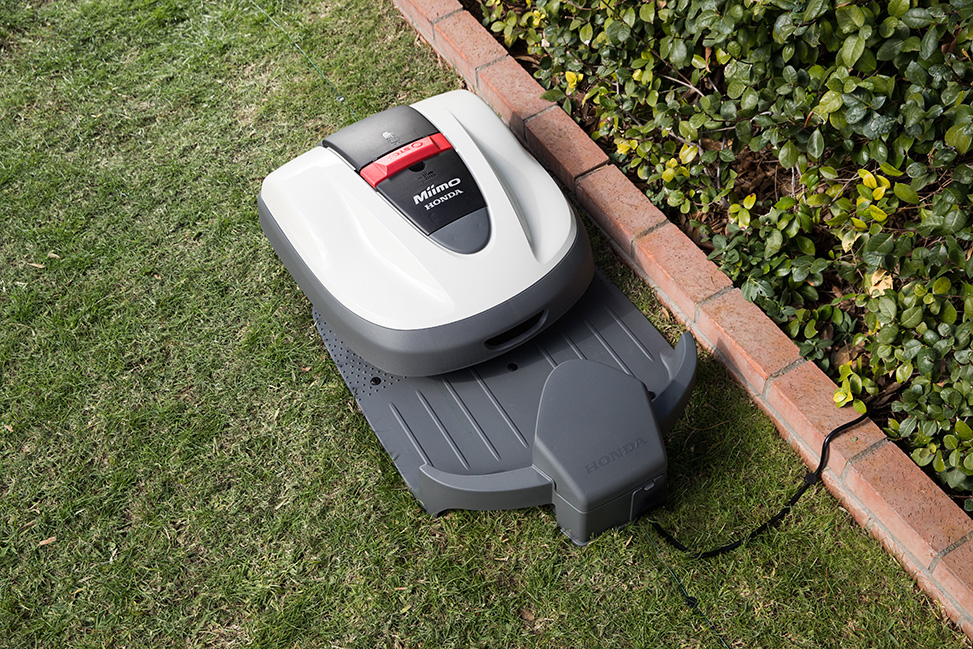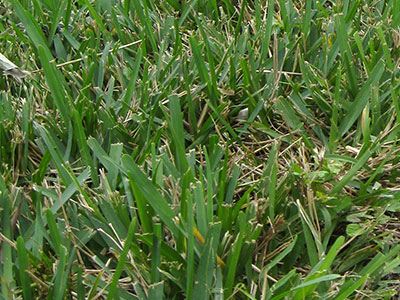
by Matthew Orwat | Mar 20, 2020
Participants will learn the symptoms of large patch disease, best management practices to prevent large patch disease, fungicide management plan to treat large patch disease, and how to identify large patch disease under a microscope, mosaic and lethal virus necrosis of St. Augustine grass. – Presented by Dr. Phil Harmon, UF/IFAS Extension Plant Pathologist.
Turf Disease Training
Thursday, April 2, 2020
Presentation thru “Zoom” online
9:00 am (CDT) – 10:30 am (CDT) – FREE
To register, please follow this link!

St.Augustinegrass – Image credit, UF / IFAS Solutions
For questions about the webinar, please contact:
Grantly E. Ricketts
Commercial Horticulture
UF/IFAS Extension, Osceola County
321-697-3000
gricketts@ufl.edu

by Matt Lollar | Aug 1, 2019
Large patch Rhizoctonia solani (known as brown patch in cool season grasses) is a common disease of many turfgrass species. It usually occurs during the cooler months from October through May when temperatures are below 80 degrees Fahrenheit. However, signs and symptoms of large patch and other Rhizoctonia diseases can be observed throughout the summer. Less common Rhizoctonia species that occur during the summer months are Rhizoctoni zeae and Rhizoctonia oryzae. Extended periods of turf wetness from excessive rainfall or overwatering provide ideal conditions for the disease to develop and spread.
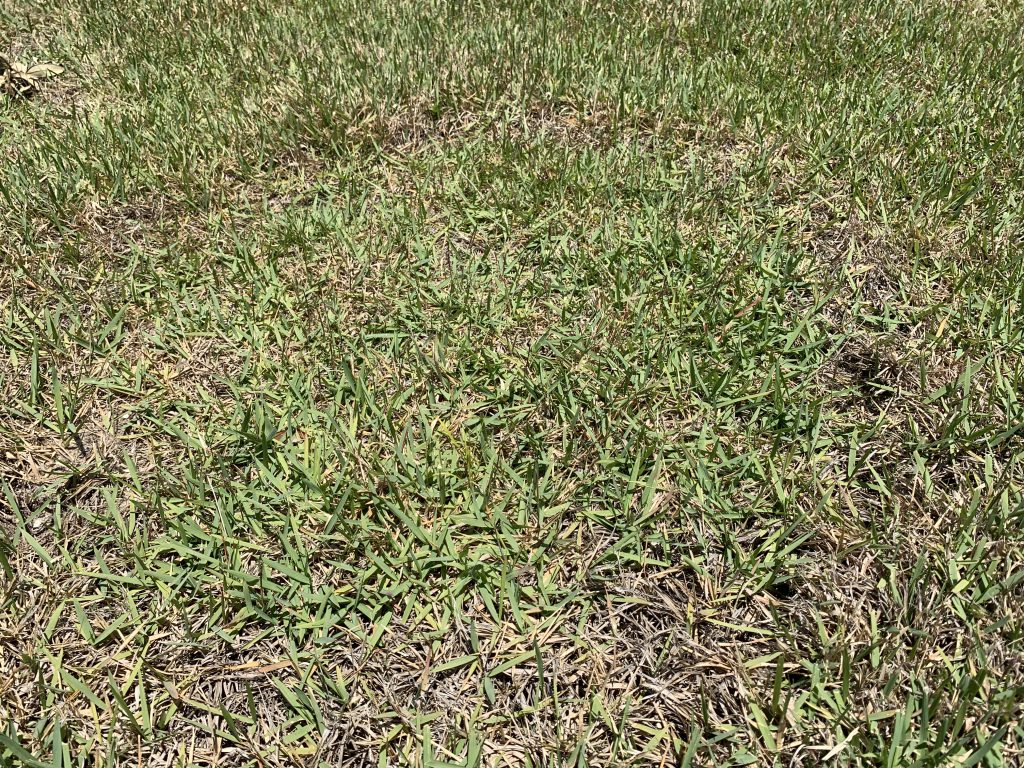
Rhizoctonia in a zoysiagrass lawn. Photo Credit: Matt Lollar, University of Florida/IFAS Extension – Santa Rosa County
This summer in Santa Rosa County, Rhizoctonia has been positively diagnosed in both St. Augustinegrass and zoysiagrass lawns and suspected in a number of centipedegrass lawns. The disease usually starts as small, yellow patches (about a foot in diameter) that turn reddish brown, brown, or straw colored as the leaves start to die. Patches often expand to several feet in diameter. It is common to see rings of yellow or brown turf with otherwise healthy turf in the center. The fungus infects portions of the blades closest to the soil, eventually killing the entire leaf. Grass blades can easily be pulled off their stems, but roots are not affected by the disease.
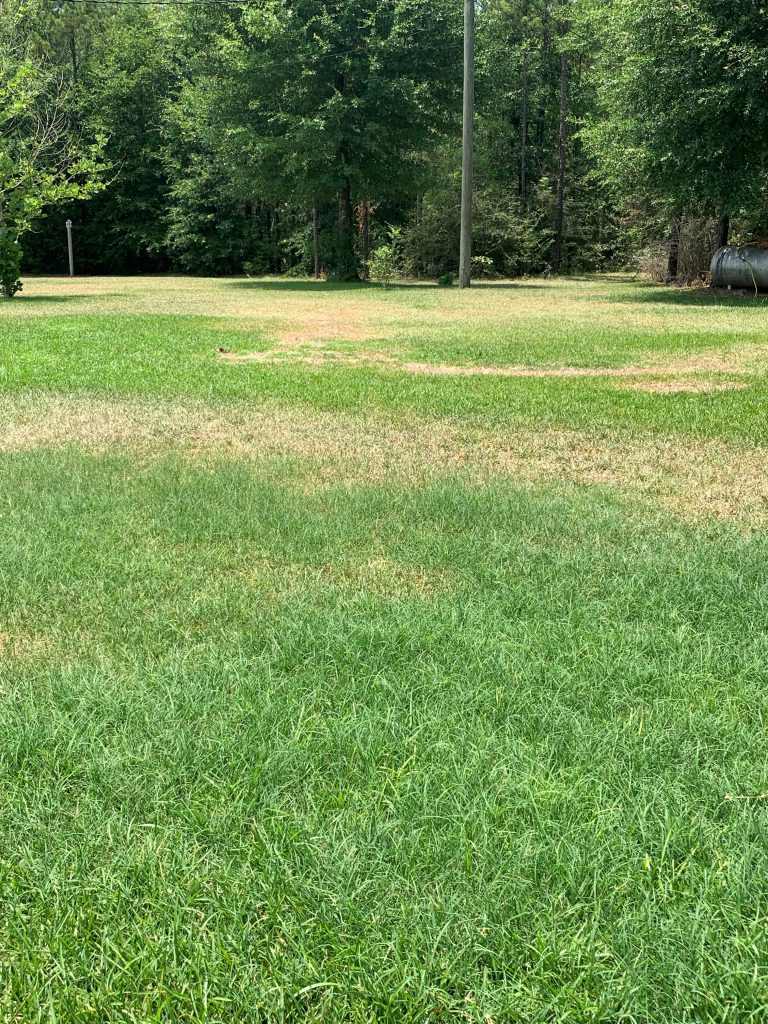
Rhizoctonia in a St. Augustinegrass lawn. Photo Credit: John Atkins, University of Florida/IFAS Extension – Santa Rosa County
Overwatering and excessive fertilization can both contribute to the development of Rhizoctonia disease. Improper timing of fertilizer application can also promote disease development. In the Florida Panhandle, turfgrass is actively growing from April to October. Slow-release fertilizers are recommended to allow for a more even distribution of nutrients over the course of multiple months. Recommended fertilizer rates are based on turfgrass species, geographical location, and fertilizer analysis. Please refer to the UF/IFAS Publication: “Urban Turf Fertilizer Rule for Home Lawn Fertilization” for rate recommendations.
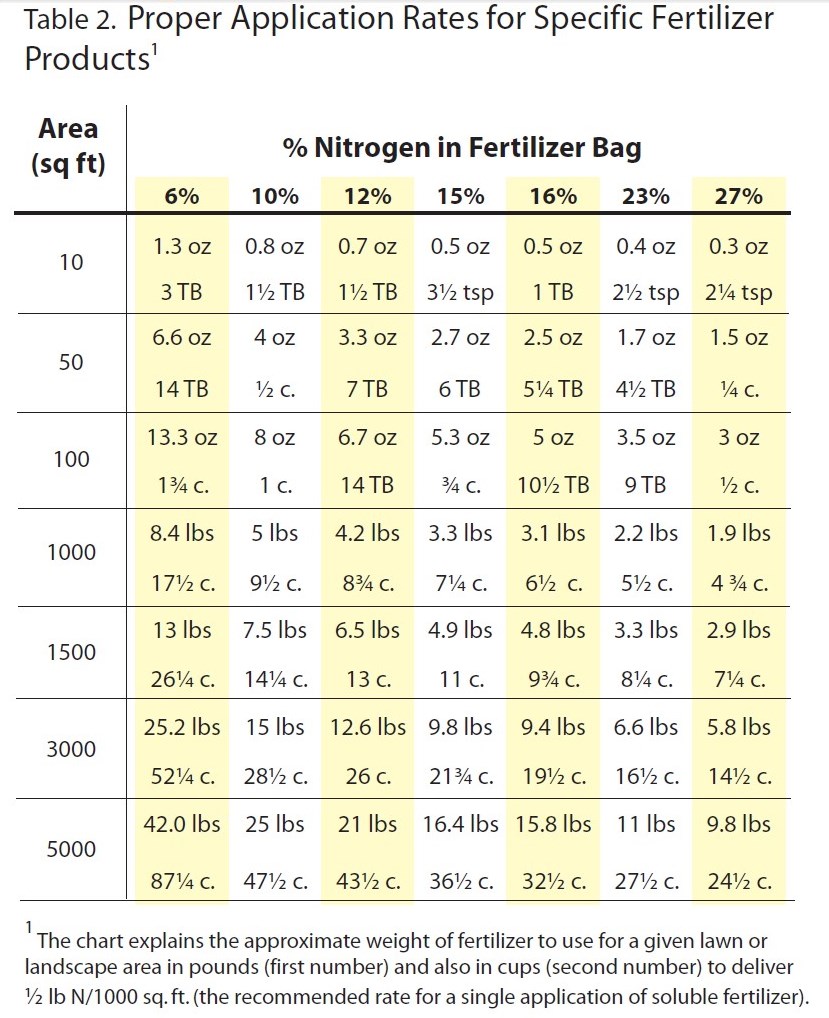
Chart excerpted from Florida-Friendly Landscaping publication.
If large patch or another Rhizoctonia disease is confirmed in your lawn, then chemical controls are necessary to keep the disease from spreading. Fungicide products containing the active ingredients azoxystrobin, chlorothalonil, fludioxonil, flutolanil, iprodione, mancozeb, metconazole, myclobutanil, polyoxin D, propiconazole, thiophanate-methyl, thiram, triadimefon, trifloxystrobin, or triticonazole are viable options for keeping the disease from spreading. For best results, follow the fungicide label for application instructions. It’s important to not only treat the affected areas, but also the healthy turf surrounding these areas in order to keep the diseased spots from growing in size.
Unfortunately, turf diseases are often not noticed until large patches of declining and dead turf are noticed. In these cases when large dead patches exist in the lawn, it is usually necessary to resod these areas. As with most problems that arise in the landscape, good cultural practices are the most proactive way to mitigate the chances with turfgrass diseases. The UF/IFAS Florida Friendly Website provides up-to-date solutions and recommendations for caring for Florida landscapes.

by Matt Lollar | Apr 9, 2019
The Evidenced-Based Zoysiagrass Management Workshop is returning to Milton on April 23 at the University of Florida – Milton Campus. Attend to get updates on managing zoysiagrass and to earn CEUs. Register at: UF/IFAS Evidence-Based Zoysiagrass Workshop
by Matt Lollar | Jun 28, 2018
A new research project at the West Florida Research and Education Center in Jay, FL is looking into the quality of turfgrass cut with a robotic mower. The study is to determine whether the quality of St. Augustinegrass can be improved by continuous mowing with a robotic mower at 2.4″ height instead of the traditional mowing height of 3.5″, removing only a third of leaf blade material per mowing.
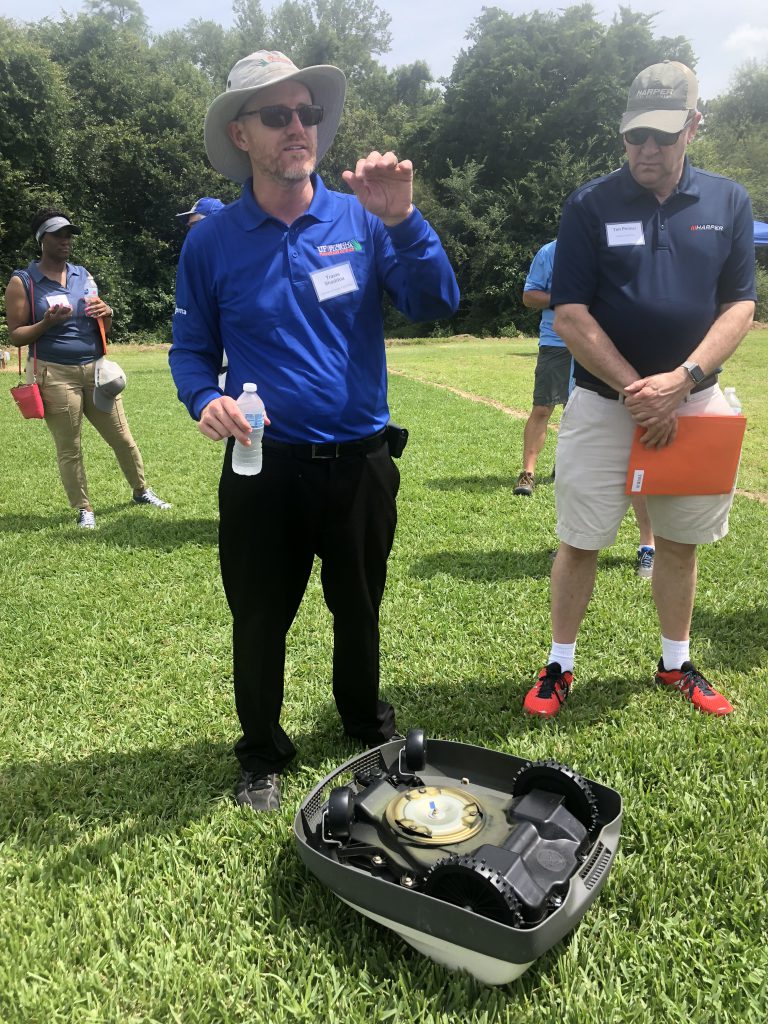
Dr. Shaddox talking to participants at the 2018 Gulfcoast Expo & Turfgrass Field Day. Photo Credit: Matt Lollar, University of Florida/IFAS Extension.
The mower being tested is the Miimo manufactured by Honda. This particular model mows and charges on its own and can mow up to 0.37 acres on one charge. It can mow in three programmable cutting patterns: directional; random; or mixed. The study is utilizing the random cutting pattern.
The mower’s three, two-sided blades are mounted on a circular head that can rotate both clockwise and counter-clockwise. The head automatically switches between clockwise and counter-clockwise rotation to reduce wear on the blades. The blades are basically just two-sided razor blades. A buried guide wire is installed on the perimeter of the lawn to serve as a boundary.
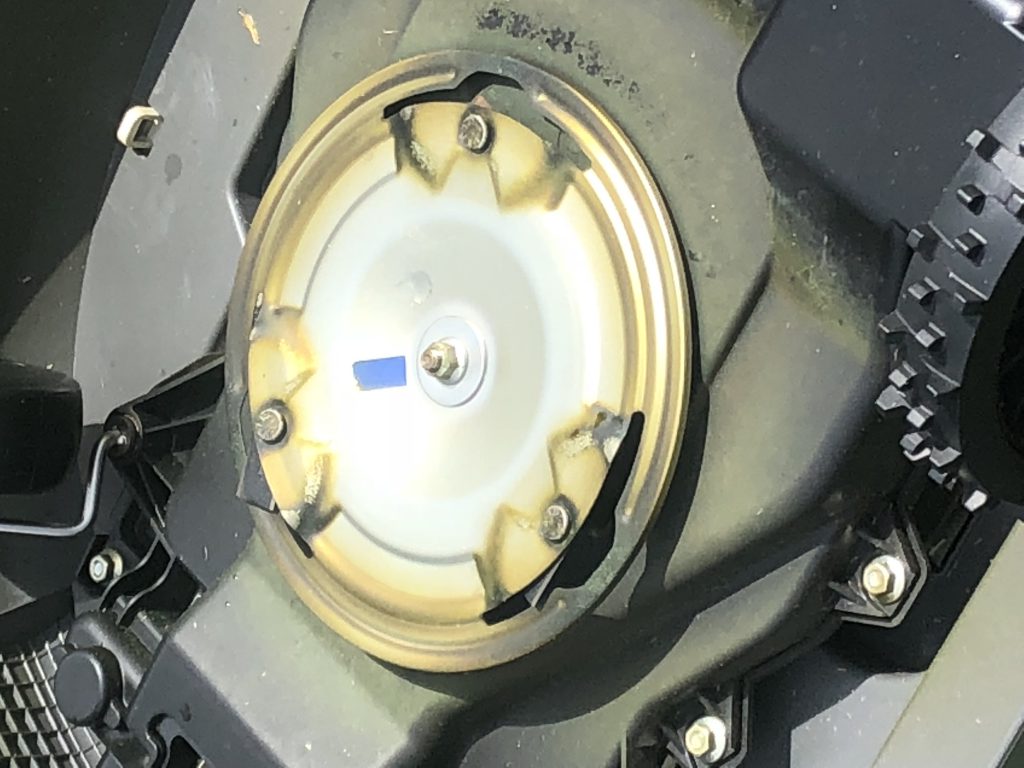
A close-up shot of the Miimo mower blades. Photo Credit: Matt Lollar, University of Florida/IFAS Extension.
So far, the plots cared for by the robotic mower look promising! The blades on the robot are much finer than those found on a common rotary mower. Because of this, they cut more cleanly and tend to tear the grass blades less often than the rotary mower. Other robotic mowers on the market include the Worx Landroid, Husqvarna Automower, and Bosch Indego. Please stay tuned for future robotic mower evaluations on other products, energy consumption, and nutrient evaluation.
by Julie McConnell | Feb 23, 2017
Regardless of what the tag says one size does not fit all. As with clothing, a piece will undoubtedly be too large for some and too small for others. Trying to go with a “one size fits all” approach to lawn care will lead to the same kind of frustration and disappointment as an ill-fitting garment.
All turfgrass is not created equal. Thus management of our various turf species requires different methods. It is common for a homeowner to be unaware of what type of turfgrass they have – it’s all grass after all – what difference does it make? Misidentification leads to problems because proper management for one type may be counterproductive to another type. In order to create a practical turf management plan, it is critical that the species of grass is properly identified.
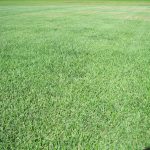
Although many grasses look similar it is important to know exactly what kind you have to maintain it properly. This photo shows Empire Zoysia. Photo credit: Julie McConnell, UF/IFAS
Why is it important to know the species of turf in a lawn?
Two of the most common mistakes extension agents observe is excessively low mowing height of St. Augustinegrass and over-fertilizing Centipedegrass. Both of these errors can reduce turfgrass vigor and decrease its tolerance to pest issues. Another potential maintenance pitfall is using a herbicide that is not labeled for use on a given type of turfgrass. Several popular herbicides available on the market can cause damage to St. Augustinegrass and/or Centipedegrass. Thus turf can be inadvertently killed by herbicides when they are applied to the wrong species.
Before a lawn maintenance plan is developed, be sure to know what type of grass is present and then follow UF/IFAS recommendations for proper care. If assistance is needed with identification, contact your local extension office.
To learn more about lawn care, visit this site or plan to attend “Caring for Your Florida Lawn” at the UF/IFAS Extension Bay County office on April 8th. For more details call 850-784-6105.








